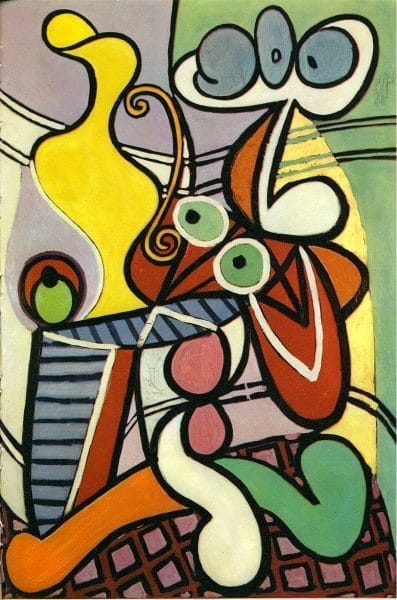San Francisco is so awash in Picasso this summer that I feel like I never left New York. First the Steins’ Picassos, then the de Young, last night Woody Alan (pleasant fluff, but what a one-dimensional Picasso; though I suppose Woody may not have needed any more dimensions in the service of his film), and we haven’t yet even gotten to the ceramics show at the Legion of Honor. The Steins Collect show at the SFMOMA is quite wonderful (ending Sept. 6; see above), but since it trails off near the beginning of Synthetic Cubism (when Picassos grew too dear for the Steins’ budget), it is good preparation for the de Young Museum exhibit: Picasso: Masterpieces from the Musée National Picasso, Paris (till October 9). The Picasso Museum is closed for renovation till next year (among other things, they’re increasing their exhibition space by 50%–yay!), so they sent packing some 150 artworks on an international junket, first to the Seattle Art Museum, then the Virginia Museum of Fine Arts, and now to our fair city.
Picasso liked to say that he was his own greatest collector, and that he certainly was, having kept over half of his output until the end of his life. His heirs thankfully paid his inheritance taxes with art, thereby endowing France with the single largest collection of Picassos in the world. (I have read that it initially numbered 3500 works and has grown through purchases and bequests to 5000, though even the latter seems like too small a number, given the Picasso Museum’s vast print collection. I’ve had the impression that the museum has a nearly complete print collection, which alone would comprise around 2500 works, not to mention the many rare states of many of those prints. The absence of solid numbers runs deeper. Weirdly, even estimates of the total number of his creations varies widely, from 35,000 to 50,000. Alan Wofsy, the San Francisco art publisher who updated Zervos, Picasso’s catalogue raisonné of all his works except his prints, told me that his volumes include 35% more works than Zervos. Perhaps that accounts for much of the wide gulf between 35,000 and 50,000. Clearly I’m in desperate need of a fact checker–like everyone else, I guess I’m too busy gawking at the art to obsess over the statistics.)
I have often read that the French Government and the art historians in its service did not know what they were doing when choosing the artworks from Picasso’s estate. Any visit to the Musée Picasso Paris would seem to prove the contrary, since in my opinion (I would say this!), it is the most magical and marvelous interior of any building in the world. The Picasso Museum’s traveling exhibit should alone be convincing enough. There are loans and there are loans. Loans are of course telling about the generosity of the lender, and, in this case, the Picasso Museum emerges as spectacularly generous. Unlike the Stein collection, which includes many wonderful Picassos but few great masterpieces (at least in comparison to the remainder of his oeuvre–the Steins’ means were limited, after all), the de Young exhibit is an onslaught of masterpieces. One walks through the galleries in utter disbelief amidst the frontal assault of one incredibly, impossibly great work of art after another. Go there, but plan ahead–tickets will likely sell out (even for members)!
